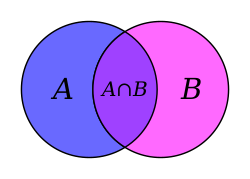Areas of advanced mathematics
As a rough guide, this list is divided into pure and applied sections although in reality, these branches are overlapping and intertwined.
Pure mathematics
Algebra
Algebra includes the study of algebraic structures, which are sets and operations defined on these sets satisfying certain axioms. The field of algebra is further divided according to which structure is studied; for instance, group theory concerns an algebraic structure called group.
- Outline of algebra
- Glossary of field theory
- Glossary of group theory
- Glossary of linear algebra
- Glossary of ring theory
- List of abstract algebra topics
- List of algebraic structures
- List of Boolean algebra topics
- List of category theory topics
- List of cohomology theories
- List of commutative algebra topics
- List of homological algebra topics
- List of group theory topics
- List of representation theory topics
- List of linear algebra topics
- List of reciprocity laws
Calculus and analysis

Calculus studies the computation of limits, derivatives, and integrals of functions of real numbers, and in particular studies instantaneous rates of change. Analysis evolved from calculus.
- Glossary of tensor theory
- List of complex analysis topics
- List of functional analysis topics
- List of integration and measure theory topics
- List of harmonic analysis topics
- List of mathematical series
- List of multivariable calculus topics
- List of q-analogs
- List of real analysis topics
- List of variational topics
- See also Dynamical systems and differential equations section below.
Geometry and topology

Geometry is initially the study of spatial figures like circles and cubes, though it has been generalized considerably. Topology developed from geometry; it looks at those properties that do not change even when the figures are deformed by stretching and bending, like dimension.
- Glossary of differential geometry and topology
- Glossary of general topology
- Glossary of Riemannian and metric geometry
- Glossary of scheme theory
- List of algebraic geometry topics
- List of algebraic topology topics
- List of circle topics
- List of curves topics
- List of differential geometry topics
- List of general topology topics
- List of geometric shapes
- List of geometric topology topics
- List of geometry topics
- List of knot theory topics
- List of Lie group topics
- List of mathematical properties of points
- List of topology topics
- List of triangle topics
Combinatorics
Combinatorics concerns the study of discrete (and usually finite) objects. Aspects include "counting" the objects satisfying certain criteria ( enumerative combinatorics ), deciding when the criteria can be met, and constructing and analyzing objects meeting the criteria (as in combinatorial designs and matroid theory), finding "largest", "smallest", or "optimal" objects ( extremal combinatorics and combinatorial optimization ), and finding algebraic structures these objects may have ( algebraic combinatorics ).
Logic

Logic is the foundation that underlies mathematical logic and the rest of mathematics. It tries to formalize valid reasoning. In particular, it attempts to define what constitutes a proof.
Number theory
The branch of mathematics deals with the properties and relationships of numbers, especially positive integers. Number theory is a branch of pure mathematics devoted primarily to the study of the integers and integer-valued functions. German mathematician Carl Friedrich Gauss said, "Mathematics is the queen of the sciences—and number theory is the queen of mathematics." Number theory also studies the natural, or whole, numbers. One of the central concepts in number theory is that of the prime number, and there are many questions about primes that appear simple but whose resolution continues to elude mathematicians.
- List of algebraic number theory topics
- List of number theory topics
- List of recreational number theory topics
- Glossary of arithmetic and Diophantine geometry
- List of prime numbers —not just a table, but a list of various kinds of prime numbers (each with an accompanying table)
- List of zeta functions
Applied mathematics
Dynamical systems and differential equations

A differential equation is an equation involving an unknown function and its derivatives.
In a dynamical system, a fixed rule describes the time dependence of a point in a geometrical space. The mathematical models used to describe the swinging of a clock pendulum, the flow of water in a pipe, or the number of fish each spring in a lake are examples of dynamical systems.
Mathematical physics
Mathematical physics is concerned with "the application of mathematics to problems in physics and the development of mathematical methods suitable for such applications and for the formulation of physical theories". 1
Theory of computation

The fields of mathematics and computing intersect both in computer science, the study of algorithms and data structures, and in scientific computing, the study of algorithmic methods for solving problems in mathematics, science, and engineering.
- List of algorithm general topics
- List of computability and complexity topics
- Lists for computational topics in geometry and graphics
- List of computer vision topics
- List of formal language and literal string topics
- List of numerical analysis topics
- List of terms relating to algorithms and data structures
Information theory and signal processing
Information theory is a branch of applied mathematics and social science involving the quantification of information. Historically, information theory was developed to find fundamental limits on compressing and reliably communicating data.
Signal processing is the analysis, interpretation, and manipulation of signals. Signals of interest include sound, images, biological signals such as ECG, radar signals, and many others. Processing of such signals includes filtering, storage and reconstruction, separation of information from noise, compression, and feature extraction.
Probability and statistics

Probability theory is the formalization and study of the mathematics of uncertain events or knowledge. The related field of mathematical statistics develops statistical theory with mathematics. Statistics, the science concerned with collecting and analyzing data, is an autonomous discipline (and not a subdiscipline of applied mathematics).
Game theory
Game theory is a branch of mathematics that uses models to study interactions with formalized incentive structures ("games"). It has applications in a variety of fields, including economics, anthropology, political science, social psychology and military strategy.
Operations research
Operations research is the study and use of mathematical models, statistics, and algorithms to aid in decision-making, typically with the goal of improving or optimizing the performance of real-world systems.